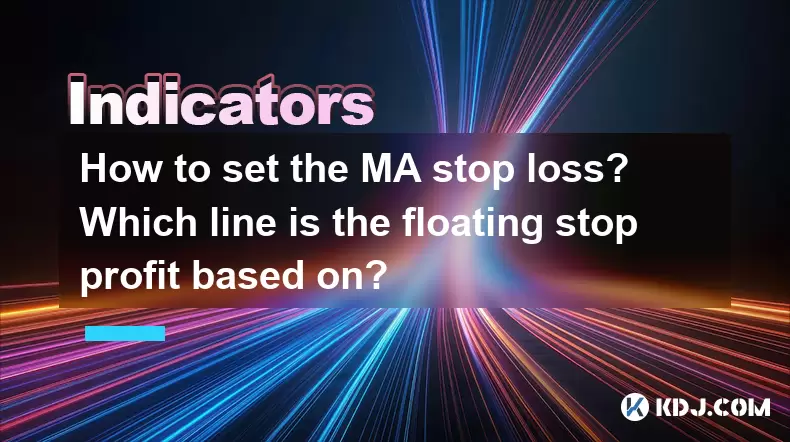-
 bitcoin
bitcoin $118548.520763 USD
3.67% -
 ethereum
ethereum $4352.564943 USD
4.79% -
 xrp
xrp $2.964058 USD
4.22% -
 tether
tether $1.000565 USD
0.05% -
 bnb
bnb $1028.372955 USD
1.46% -
 solana
solana $221.373507 USD
6.00% -
 usd-coin
usd-coin $0.999933 USD
0.02% -
 dogecoin
dogecoin $0.248633 USD
6.85% -
 tron
tron $0.341444 USD
2.38% -
 cardano
cardano $0.852946 USD
5.82% -
 hyperliquid
hyperliquid $47.869306 USD
6.15% -
 chainlink
chainlink $22.561476 USD
6.01% -
 ethena-usde
ethena-usde $1.001258 USD
0.05% -
 avalanche
avalanche $30.660000 USD
2.06% -
 stellar
stellar $0.400917 USD
9.76%
How to set the MA stop loss? Which line is the floating stop profit based on?
An MA stop loss uses moving averages to exit trades and minimize losses, while a floating stop profit locks in gains as the market moves favorably.
May 21, 2025 at 12:01 pm

Understanding the MA Stop Loss
Setting an MA (Moving Average) stop loss is a strategy used by traders to protect their investments in the cryptocurrency market. An MA stop loss involves using moving averages to determine when to exit a trade to minimize losses. This method is particularly useful in the volatile crypto market, where prices can fluctuate dramatically in short periods. By setting an MA stop loss, traders can automate the process of exiting trades when the market moves against their positions, helping to preserve capital and manage risk effectively.
Steps to Set an MA Stop Loss
To set an MA stop loss, traders need to follow a series of steps. Here's how to do it:
Choose the appropriate moving average: Decide on the type of moving average (Simple Moving Average, Exponential Moving Average, etc.) and the period that suits your trading strategy. For example, a 20-day SMA might be used for a medium-term strategy.
Determine the stop loss level: Once you have selected your moving average, you need to decide at what point below the MA you will set your stop loss. A common approach is to set the stop loss a certain percentage or fixed amount below the moving average line.
Implement the stop loss in your trading platform: Most trading platforms allow you to set stop loss orders. You will need to enter the stop loss price, which is calculated based on the moving average and your chosen buffer.
Monitor and adjust: Keep an eye on the market and adjust your stop loss as needed. As the moving average changes, you may need to update your stop loss to reflect the new price levels.
The Concept of Floating Stop Profit
A floating stop profit, also known as a trailing stop, is a strategy used to lock in profits as the market moves in your favor. The floating stop profit is based on the highest price reached by the asset since you entered the trade. This means that as the price of the cryptocurrency increases, the stop profit level moves up with it, but if the price starts to fall, the stop profit level remains at its highest point, allowing you to secure gains.
Setting Up a Floating Stop Profit
To set up a floating stop profit, follow these steps:
Determine the trailing amount: Decide on the percentage or fixed amount by which the stop profit will trail the highest price. For example, you might set a trailing stop of 5% below the highest price.
Enter the trailing stop order: In your trading platform, enter a trailing stop order with the specified trailing amount. This will automatically adjust the stop profit level as the price moves.
Monitor and adjust: As with the MA stop loss, it's important to monitor the market and adjust your trailing stop as needed. If the market becomes more volatile, you might need to adjust the trailing amount to avoid being stopped out prematurely.
Choosing the Right Line for Floating Stop Profit
The line on which the floating stop profit is based is the highest price reached by the asset since the trade was entered. This is different from the MA stop loss, which is based on a moving average line. The highest price line is dynamic and adjusts as the market moves, providing a more aggressive approach to locking in profits.
Practical Example of MA Stop Loss and Floating Stop Profit
To illustrate how these strategies work in practice, consider a scenario where you buy Bitcoin at $30,000. You decide to use a 20-day SMA for your MA stop loss and set it at 5% below the SMA. If the 20-day SMA is currently at $31,000, your stop loss would be at $29,450 ($31,000 - 5%). As the SMA moves, you would adjust your stop loss accordingly.
For the floating stop profit, you set a trailing stop of 5% below the highest price. If Bitcoin reaches a high of $35,000, your stop profit would be at $33,250 ($35,000 - 5%). If the price continues to rise to $40,000, your stop profit would move to $38,000 ($40,000 - 5%). If the price then falls, your stop profit remains at $38,000, securing your profits.
Frequently Asked Questions
Q: Can I use both MA stop loss and floating stop profit together?Yes, you can use both strategies simultaneously. The MA stop loss helps protect against significant losses, while the floating stop profit allows you to lock in gains as the market moves in your favor. Combining these strategies can provide a balanced approach to risk management.
Q: How do I choose the right period for my moving average?The choice of period for your moving average depends on your trading strategy and time horizon. Short-term traders might use a shorter period, such as a 5-day or 10-day moving average, while long-term investors might prefer a longer period, like a 50-day or 200-day moving average. Experiment with different periods to find what works best for your trading style.
Q: What happens if the market gaps past my stop loss or stop profit levels?If the market gaps past your stop loss or stop profit levels, your order will be executed at the next available price, which could be significantly different from your set levels. This is known as slippage and is a risk in volatile markets. To mitigate this, some traders use guaranteed stop losses, which ensure execution at the specified price but may come with additional fees.
Q: Can I automate these strategies using trading bots?Yes, many trading bots and platforms allow you to automate both MA stop loss and floating stop profit strategies. These bots can monitor the market and adjust your stop levels automatically based on your predefined rules. However, it's important to thoroughly test and monitor any automated system to ensure it performs as expected.
Disclaimer:info@kdj.com
The information provided is not trading advice. kdj.com does not assume any responsibility for any investments made based on the information provided in this article. Cryptocurrencies are highly volatile and it is highly recommended that you invest with caution after thorough research!
If you believe that the content used on this website infringes your copyright, please contact us immediately (info@kdj.com) and we will delete it promptly.
- BlockDAG, DOGE, HYPE Sponsorship: Crypto Trends Shaping 2025
- 2025-10-01 00:25:13
- Deutsche Börse and Circle: A StableCoin Adoption Powerhouse in Europe
- 2025-10-01 00:25:13
- BlockDAG's Presale Buzz: Is It the Crypto to Watch in October 2025?
- 2025-10-01 00:30:13
- Bitcoin, Crypto, and IQ: When Genius Meets Digital Gold?
- 2025-10-01 00:30:13
- Stablecoins, American Innovation, and Wallet Tokens: The Next Frontier
- 2025-10-01 00:35:12
- NBU, Coins, and Crypto in Ukraine: A New Yorker's Take
- 2025-10-01 00:45:14
Related knowledge

What is a tower bottom candlestick pattern? Does it have a high success rate?
Sep 22,2025 at 07:18am
Tower Bottom Candlestick Pattern Explained1. The tower bottom candlestick pattern is a reversal formation that typically appears at the end of a downt...

What is a black hole pattern in the MACD indicator? Is it a cause for concern?
Sep 21,2025 at 06:54pm
Bitcoin's Role in Decentralized Finance1. Bitcoin remains the cornerstone of decentralized finance, serving as a benchmark for value and security acro...

How can I use the psychological line (PSY) to determine market sentiment?
Sep 17,2025 at 02:19pm
Understanding the Psychological Line (PSY) in Cryptocurrency TradingThe Psychological Line, commonly referred to as PSY, is a momentum oscillator used...

How can I determine if a double top pattern has officially formed?
Sep 21,2025 at 03:18am
Understanding the Structure of a Double Top Pattern1. A double top pattern consists of two distinct peaks that reach approximately the same price leve...

What is the Golden Valley pattern on the moving average? Is it better than the Silver Valley pattern?
Sep 21,2025 at 02:54pm
Understanding the Golden Valley Pattern in Moving Averages1. The Golden Valley pattern is a technical formation observed in cryptocurrency price chart...

What does a death cross of the RSI in the strong zone (above 50) mean?
Sep 17,2025 at 10:54pm
Understanding the Death Cross in RSI Context1. The term 'death cross' is traditionally associated with moving averages, where a short-term average cro...

What is a tower bottom candlestick pattern? Does it have a high success rate?
Sep 22,2025 at 07:18am
Tower Bottom Candlestick Pattern Explained1. The tower bottom candlestick pattern is a reversal formation that typically appears at the end of a downt...

What is a black hole pattern in the MACD indicator? Is it a cause for concern?
Sep 21,2025 at 06:54pm
Bitcoin's Role in Decentralized Finance1. Bitcoin remains the cornerstone of decentralized finance, serving as a benchmark for value and security acro...

How can I use the psychological line (PSY) to determine market sentiment?
Sep 17,2025 at 02:19pm
Understanding the Psychological Line (PSY) in Cryptocurrency TradingThe Psychological Line, commonly referred to as PSY, is a momentum oscillator used...

How can I determine if a double top pattern has officially formed?
Sep 21,2025 at 03:18am
Understanding the Structure of a Double Top Pattern1. A double top pattern consists of two distinct peaks that reach approximately the same price leve...

What is the Golden Valley pattern on the moving average? Is it better than the Silver Valley pattern?
Sep 21,2025 at 02:54pm
Understanding the Golden Valley Pattern in Moving Averages1. The Golden Valley pattern is a technical formation observed in cryptocurrency price chart...

What does a death cross of the RSI in the strong zone (above 50) mean?
Sep 17,2025 at 10:54pm
Understanding the Death Cross in RSI Context1. The term 'death cross' is traditionally associated with moving averages, where a short-term average cro...
See all articles










































































